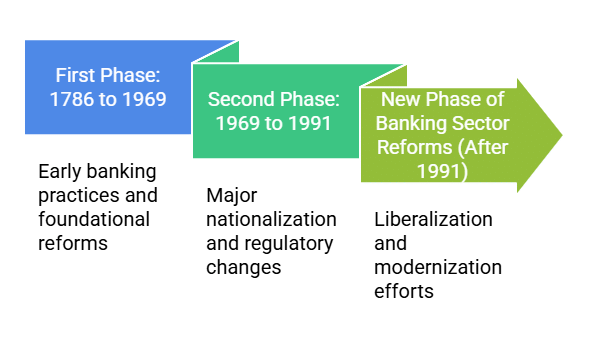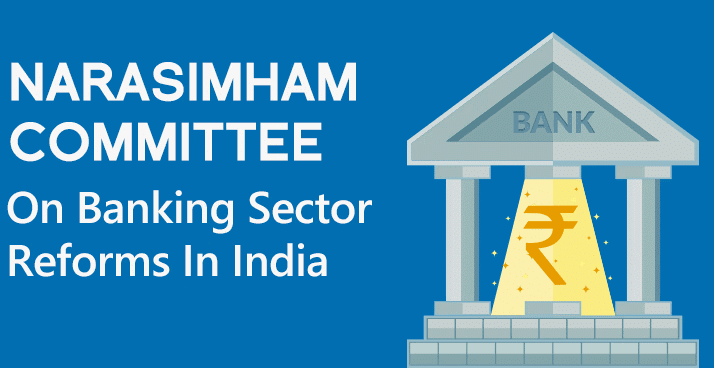Banking Sector Reforms From 1786 to 1991 | IBPS PO Prelims & Mains Preparation - Bank Exams PDF Download
Introduction
The Indian banking system has undergone a remarkable transformation over the past two centuries. From the establishment of the first banks during British rule to post-independence nationalisations, and finally to liberalisation and modernisation in the post-1991 era, the banking sector in India has continually evolved to meet the demands of a growing and dynamic economy. This transformation has been marked by various reform phases aimed at increasing financial inclusion, enhancing operational efficiency, strengthening regulation, and embracing technology.
The banking reforms in India can be broadly categorised into three major phases:

First Phase: 1786 to 1969
In 1786, the first bank in India, initially called the Bank of Hindustan and Bengal Bank, was established. It was later renamed the General Bank of India.- The British East India Company founded three banks:
i) Bank of Bengal in 1809
ii) Bank of Bombay in 1840
iii) Bank of Madras in 1843 - These banks operated independently and became known as the Presidency Banks.
- In 1920, the Bank of Bengal, Bank of Bombay, and Bank of Madras merged to form the Imperial Bank of India, primarily owned by private shareholders, mostly Europeans.
- The Allahabad Bank was founded by Indians in 1865.
- Punjab National Bank (PNB) was established in 1894 in Lahore, now headquartered in New Delhi.
- Between 1906 and 1913, several banks were established, including the Bank of India, Central Bank, Bank of Baroda, Canara Bank, Indian Bank, and Bank of Mysore.
- The Reserve Bank of India was founded in 1935 under the RBI Act of 1934.
- To regulate commercial banks, the Government of India introduced the Banking Companies Act, 1949, later renamed the Banking Regulation Act, 1949.
 History of Indian banking
History of Indian banking
Second Phase: Banking Sector Reforms from 1969 to 1991
- In 1955, the Imperial Bank of India was nationalised by the Government of India to expand banking services, especially in rural and semi-urban areas.
- The State Bank of India was established by the Government of India to act as the primary agent of the Reserve Bank of India (RBI) and oversee banking operations for the central and state governments across the country.
- In 1959, seven banks owned by Princely states were nationalised as part of broader banking reforms. By 1969, a total of 14 commercial banks had been nationalised.
- During the banking sector reforms, an additional seven banks were nationalised in 1980, leading to government ownership of 80% of India’s banking sector.
New Phase of Banking Sector Reforms (After 1991)
- This phase is known as the Reformatory Phase and is essential for economic growth.
- During this period, many new products and services were introduced in the banking sector.
- In 1991, a committee led by M. Narasimham was formed to address issues in the Indian banking system and promote liberalisation of banking practices.
- The Narasimham Committee identified several critical issues, including the Direct Investment Programme, Direct Credit Programme, interest rate structure, necessary changes to banking systems, and transparency concerns within Indian banks.
- This period witnessed an influx of foreign banks and their ATM services, aiming to enhance customer service.
- Innovations like core banking, phone banking, internet banking, and electronic transactions were introduced, making banking more convenient and efficient.
- The Narasimham Committee I (1991) was established to improve the financial health of commercial banks, ensuring their efficient and profitable operation. It focused on identifying issues within Indian banks and recommending enhancements for financial institutions.
- In 1998, the Government of India appointed another committee, also chaired by M. Narasimham, to evaluate progress and design a programme for further strengthening the financial system if needed.
- The Narasimham Committee II (1998) emphasised structural measures and enhancing standards of disclosure and transparency, focusing on areas like capital adequacy, bank mergers, banking laws, and legislative reviews.
- Both Narasimham Committees submitted their reports in 1991 and 1998, respectively, containing key recommendations.

Major Recommendations of Narasimham Committee I
- Reduction of Cash Reserve Ratio (CRR) and Statutory Liquidity Ratio (SLR): The committee recommended lowering these ratios to enhance liquidity in the banking system.
- Establishing Capital Adequacy Norms: Setting guidelines for capital adequacy in banks to ensure financial stability and risk management.
- Deregulation of Interest Rates: Allowing banks to set their interest rates freely to promote competition and efficiency.
- Improving Recovery of Non-Performing Assets (NPAs): Strengthening mechanisms for recovering bad loans to improve the financial health of banks.
- Asset Classification: Revising the classification of assets to reflect their true value and risk.
- Enhancing Access to Capital Markets: Facilitating better access for banks and financial institutions to capital markets for funding.
- Development of Regional Rural Banks: Promoting the growth and efficiency of Regional Rural Banks to enhance rural banking services.
- Restructuring of Banks: Encouraging the restructuring of banks for improved efficiency and focus.
- Implementing Transparency Measures: Enhancing transparency in banking operations and financial disclosures.
- Supervision of Banks: Strengthening the supervision and regulatory framework for banks.
- Fostering Competition: Promoting the entry of new private sector banks to enhance competition in the banking sector.
- Licensing of Banking Branches: Revising the licensing process for bank branches to promote expansion and service delivery.
- Income Recognition: Standardizing income recognition practices to ensure consistency and accuracy.
- Allowing Foreign Banks: Permitting foreign banks to operate in India to enhance competition and service quality.
Major Recommendations of Narasimham Committee II
- New Areas in Banking: The committee suggested exploring new areas within the banking sector to enhance its scope and operations.
- Introduction of New Instruments: It recommended the introduction of new financial instruments within the banking system to diversify offerings and improve financial services.
- Bank Ownership Reform: The committee advocated for reforms in bank ownership to ensure better governance and operational efficiency.
- Risk Management Practices: Emphasizing the importance of robust risk management practices to safeguard against potential financial risks.
- Enhancing Customer Service: The committee highlighted the need for improving customer service standards in banks to enhance customer satisfaction and trust.
- Promotion of Universal Banking: It recommended the promotion of universal banking in India to provide a wide range of financial services under one roof.
- Exploration of Narrow Banking: The committee suggested exploring the concept of narrow banking in India to focus on specific banking activities.
- Strengthening Banking Systems through Technology: Advocating for the use of technology to strengthen banking systems and improve efficiency.
- Increase in Inflow of Credit: The committee recommended measures to increase the inflow of credit to support economic growth and development.
- Establishment of a Credit Information Bureau: It suggested the establishment of a Credit Information Bureau to enhance credit information sharing and transparency.
- Implementation of Anti-Money Laundering Guidelines: Recommending strict guidelines for anti-money laundering to prevent financial crimes.
- Encouraging Mergers and Amalgamation: The committee advocated for encouraging mergers and amalgamation in the banking sector to create stronger entities.
- Raising the Foreign Direct Investment (FDI) Limit: Suggesting an increase in the FDI limit to attract foreign investment in the banking sector.
- Development of Information Technology: Emphasizing the development of information technology to support banking operations and services.
Way Forward: Building a Stronger and Smarter Banking Future
The growth of Indian banking—from the time of British rule to today’s modern, tech-driven system—shows how strong and adaptable the sector has been. Nationalising banks helped bring banking services to rural areas and ensured more people could access them. After 1991, new reforms brought in competition, better services, and modern technology. The Narasimham Committees played a major role in shaping today’s open and efficient banking system.
But some problems still remain, like increasing bad loans (NPAs), cyber-security risks, and customer complaints. To move forward, the focus should be on:
Expanding digital banking and using more fintech solutions
Improving rules and systems to manage risks better
Making sure banking reaches every part of the country
Promoting banking that is environmentally friendly and socially responsible
With ongoing improvements and strong regulation, the Indian banking sector can become even stronger, more inclusive, and ready to compete at the global level.
|
670 videos|1101 docs|322 tests
|
FAQs on Banking Sector Reforms From 1786 to 1991 - IBPS PO Prelims & Mains Preparation - Bank Exams
| 1. What were the major banking sector reforms implemented during the period from 1786 to 1969? |  |
| 2. How did the establishment of the First Bank of the United States impact the banking sector? |  |
| 3. What was the significance of the Glass-Steagall Act in the banking sector reforms? |  |
| 4. How did the Banking Act of 1935 contribute to banking sector reforms? |  |
| 5. What role did the Federal Reserve System play in the banking sector reforms during this period? |  |





















